Internal Developer Platforms (IDPs) have become a critical component of modern software engineering practices. As organizations shift towards microservices, cloud-native development, and Ops, there is a growing need for a centralized platform that can streamline development workflows.IDPs help unify disparate systems, enable collaboration between developers and operations teams, standardize configurations, and automate provisioning and deployment processes. With the right IDP, engineering teams can release high-quality software faster and more efficiently.In this article, we’ll understand the key internal developer platforms available today and a set of criteria to evaluate them.## Why Are IDPs Important? There are a few major reasons why businesses consider picking an IDP.- **Increased developer productivity: **IDPs eliminate tedious setup tasks and enable developers to focus on writing code. Provisioning environments, configuring infrastructure, and managing dependencies is automated.
- Improved developer experience: IDPs provide self-service portals and APIs for developers. This removes bottlenecks and friction caused by complex ticketing workflows.
- Greater collaboration: With an IDP, developers work closely with ops teams instead of in silos. This leads to building software that addresses business needs effectively.
- Reduced time to market: IDPs enable continuous delivery and deployment pipelines. New features and fixes can be shipped to customers faster.
- Optimized costs: IDPs provide visibility into resource usage and help teams avoid over-provisioning of infrastructure which drives down costs.
- Enhanced security: Standardized configurations and integrations with secret management and access systems enable IDPs to bake in security best practices.
- Increased resilience: IDPs leverage infrastructure-as-code and policy-driven orchestration making apps and systems more resilient to failures.But with so many IDPs out there, how do you pick the right one for your needs? And what should you look for in an IDP before picking one?## How to Select The Right Internal Developer Platform?
With a wide range of IDP solutions available today, how do you select the right one for your needs? Here are some key criteria to evaluate:### Scalability
Flexibility and scalability should be top priorities. As your teams and microservices architecture grow, the IDP must seamlessly scale up compute, storage and networking resources to match demand. Auto-scaling and dynamic provisioning capabilities are something to look for. The main object s### Integration capabilities
Integration with existing toolchain is another major factor. Tight integration with code repositories, CI/CD pipelines, monitoring stacks, secret managers etc will maximize efficiency and if you can find an IDP that’s API-driven with no/low code configurations, you have found a winner.### Ease of use
The IDP must offer intuitive self-service capabilities via GUI and CLI so developers can provision resources and manage workflows themselves. Look for one that does not overcomplicate the existing workflows instead of simplifying them for the developers.### Security
Data security, access controls, and policy enforcement are critical IDP requirements. Assess how the IDP safeguards IP, codifies and enforces security policies, and integrates with your existing security landscape.### Cost
And lastly, costs should be evaluated. Opt for flexible models that allow efficient utilization of cloud infrastructure and resources. Make sure the IDP provides visibility into resource allocation and spending.## Top 7 Internal Developer Platforms You Should Consider in 2023
Let’s look at seven of the best IDP solutions out there that you must consider if you’re planning to upgrade your internal workflows.## 1. Facets
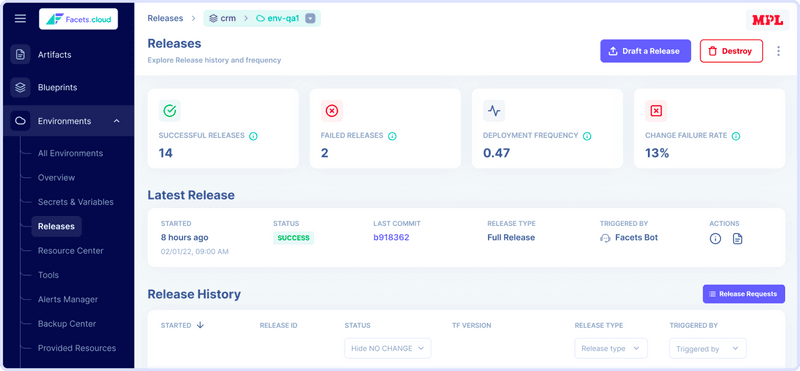 Facets.Cloud is a comprehensive Internal Developer Platform built to unify developer and ops workflows. It accelerates software delivery by up to 20% while reducing cloud costs and maintenance overheads substantially.It is designed to be extensible by default, giving you a platform to build additional custom features on, while the core of the product is developed and maintained by Facets.This gives you the benefits of both an IDP you can custom build and the ones you buy. This extensibility also means, developers don’t need to adjust to new workflows since the IDP adjusts to the existing one.#### Key capabilities
Facets.Cloud is a comprehensive Internal Developer Platform built to unify developer and ops workflows. It accelerates software delivery by up to 20% while reducing cloud costs and maintenance overheads substantially.It is designed to be extensible by default, giving you a platform to build additional custom features on, while the core of the product is developed and maintained by Facets.This gives you the benefits of both an IDP you can custom build and the ones you buy. This extensibility also means, developers don’t need to adjust to new workflows since the IDP adjusts to the existing one.#### Key capabilities - Unified interface for Devs and Ops: Facets provides a centralized portal for developers, ops engineers, and other technical teams to collaborate closely. Users get a single pane of glass into the entire infrastructure.
- Automated environment provisioning: Development, testing, staging, and production environments can be setup with a single click. The platform codifies configurations for reuse and ensures consistency across environments.
- No code infrastructure automation: Don’t spend time building infrastructure-as-code. Facets automatically writes the code for you while you can use the no-code automation.
- Microservice catalog: Facets automatically creates a catalog of all microservices/systems in your architecture. You get a bird's eye view of services, their dependencies, and health.
- Extensible platform: Facets integrates smoothly with your existing tools like CI/CD systems, monitoring, log management etc. It acts as a glue that unifies your toolchain.
- Reusable architecture blueprints: Ops engineers can define reusable architecture templates that come preloaded with best practices baked-in. Developers can spin up new projects rapidly starting from validated templates.
- Standardized workflows: Facets streamlines and codifies processes for deployment, testing, monitoring, and incident response. This brings in standardization without impacting velocity.#### Key benefits
Facets.Cloud accelerates developer velocity through automation while enhancing reliability through policy-driven guardrails. It helps prevents drift and slashes maintenance overhead by standardizing best practices throughout the organization. The unique extensibility provides integrations across your cloud-native toolchain out-of-the-box. All this results in an average of 20% faster innovation, 28% lower cloud costs, 80% reduced ops toil, accelerated time-to-market, enhanced resilience and security, and optimized costs through visibility. **If you want a tool that’s built to be extensible and fits your existing workflows like a piece of a puzzle, give Facets a go.#### Customer testimonials
"With Facets we can now focus on high-value activities and not mundane Ops." - Suyash Katyayani, Co-Founder & CTO, Purplle**"We were able to reduce our cloud costs by 35% in the first 3 months of using Facets, while improving developer experience" - Tarun Tiwari, VP Engineering, Agara LabsFacets.Cloud offers enterprise-grade capabilities combined with outstanding usability. With Facets, you get a uniquely extensible IDP platform that adapts to your workflow needs instead of dictating processes.## 2. Portainer
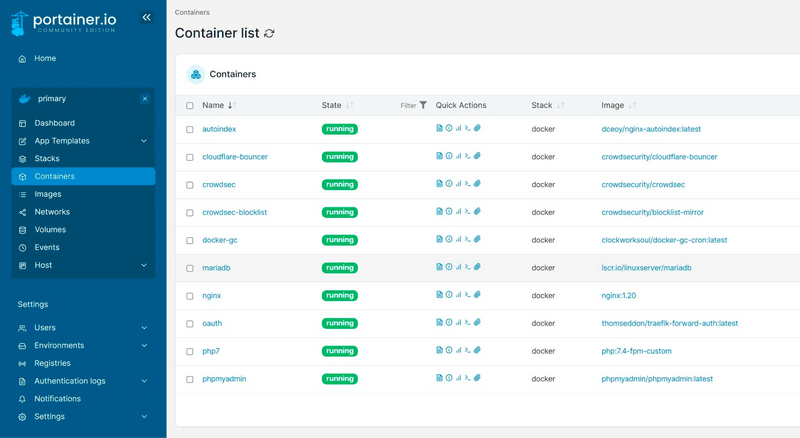 Portainer aims to simplify container management and deployments for organizations. It works with Docker, Kubernetes and ACI and offers robust security features and is versatile enough to work in diverse environments, including IoT.#### Key features
Portainer aims to simplify container management and deployments for organizations. It works with Docker, Kubernetes and ACI and offers robust security features and is versatile enough to work in diverse environments, including IoT.#### Key features - Single pane of glass: Centralized interface to manage all your Docker and Kubernetes environments irrespective of where they run - cloud, on-premises or edge.
- Simplified container adoption: Abstraction of container complexities allows teams with limited expertise to work with containerized applications.
- Pre-built templates and stacks: Quickly deploy containerized workloads using pre-built templates for common application stacks.
- Role-based access control (RBAC): Control access to resources and environments through granular role definitions.
- Security: Integration with authentication providers, vulnerability scanning, and image signing ensures enhanced security.#### Key Benefits
Portainer makes container adoption effortless even for non-experts through abstractions that hide complexity enabling centralized management. Portainer improves productivity through simple workflows, templating, and automation that eliminate infrastructure overheads.It provides enhanced security with out-of-the-box hardening features. And it delivers consistent and simplified processes across on-prem, cloud, edge and hybrid environments.***Also Read: ***10 Best Software Release Management Tools to Streamline Your Deployment**## 3. OpsLevel
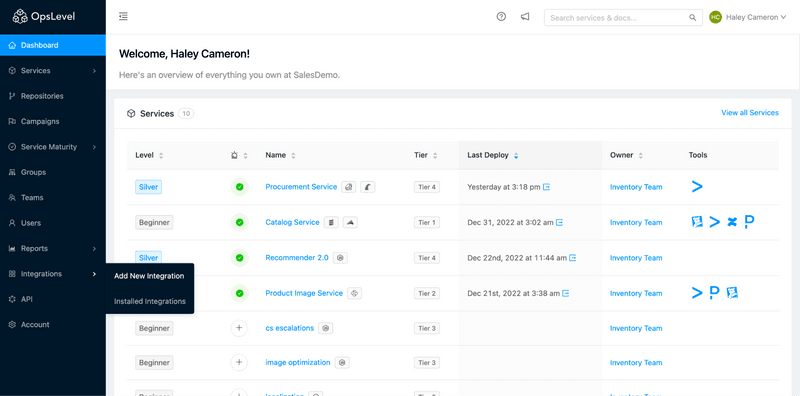 OpsLevel positions itself as a developer portal for high-performing engineering teams. It provides a centralized service catalog for microservices, enabling risk assessment, incident management, and API support. It aims to improve visibility and reliability across your software stack.#### Key capabilities
OpsLevel positions itself as a developer portal for high-performing engineering teams. It provides a centralized service catalog for microservices, enabling risk assessment, incident management, and API support. It aims to improve visibility and reliability across your software stack.#### Key capabilities - Unified service catalog: OpsLevel catalogs all your systems, microservices, teams and tools in one place. This provides a centralized source of truth.
- Reliability guardrails: It bakes best practices into reusable service templates. Things like retries, timeouts, metrics, and logs are pre-configured out-of-the-box.
- Minimized context switching: Developers get a single portal instead of jumping between different tools and interfaces. This smoothens their workflow.
- Integrations: OpsLevel integrates with your existing tools like APM, log management, CI/CD systems etc. No need to replace your current toolchain.
- Self-service for developers: It provides self-service workflows for developers to carry out tasks independently instead of relying on tickets.#### Key benefits
OpsLevel streamlines workflows for developers through self-service access and reduced context switching. By codifying reliability best practices into templates, it enhances robustness of services with minimal overhead. The end result is improved productivity, visibility and quality across your critical microservices.#### Customer testimonials
“OpsLevel is the only IDP that could impactfully improve Developer Experience across our organization.” - Maciej Sobkowiak, Principal Site Reliability Engineer*“With OpsLevel we gained full transparency into our services and dependencies which made on-call and incident management much easier.” - Quan Vu, Director of Engineering, GoGuardian*OpsLevel is purpose-built for engineering teams looking to enhance developer experience across the organization. It brings sanity to workflows for developers and ops engineers alike.## 4. Humanitec
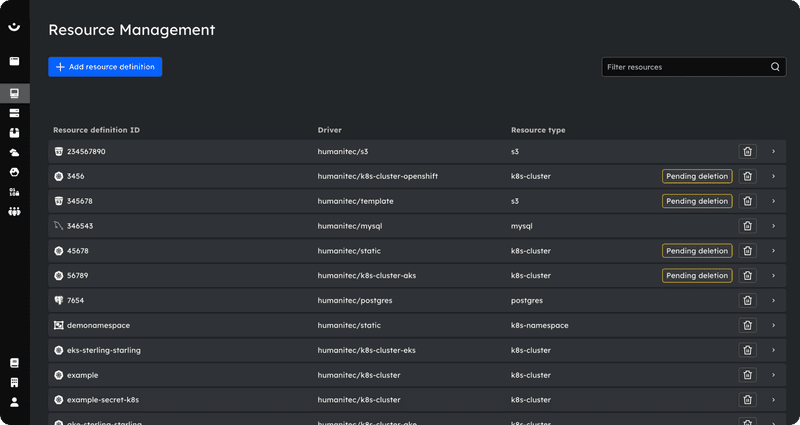 Humanitec offers a customizable Internal Developer Platform that focuses on environment management and real-time monitoring. It uses a GitOps approach to streamline workflows and improve developer experience throughout the organization#### Key features
Humanitec offers a customizable Internal Developer Platform that focuses on environment management and real-time monitoring. It uses a GitOps approach to streamline workflows and improve developer experience throughout the organization#### Key features - Standardized configurations: Humanitec dynamically generates standardized application and infrastructure configurations with every code push. This removes drift and inconsistencies.
- Streamlined operations: It enables continuous deployments and self-service workflows while maintaining compliance and controls.
- Integrates with CI/CD: Humanitec integrates out-of-the-box with Jenkins, CircleCI, GitHub Actions etc. Minimal configuration needed.
- Built-in platform orchestration: It provides the tools required to build and manage internal developer platforms tailor-made for your organization.
- Faster time to market: Automating deployments and testing workflows significantly accelerates release cycles according to Humanitec.#### Key Benefits
With its vastly simplified configurations, security integrations and streamlined deployments, Humanitec enables organizations to manage complexity safely while increasing release velocity.Compliance and controls are retained while maintenance overhead is reduced by 75% through extensive automation.It delivers 30% faster time-to-market, 95% smaller configuration boilerplate, enterprise-grade security controls, and up to 80% lowered TCO compared to custom-building internal platforms.#### Customer testimonials
“Humanitec allowed us to streamline operations without compromising on quality and security.” - Igor Kantor, Director of SW Engineering, McDonald's*“We deployed our V1 platform in just 24 minutes with Humanitec compared to a 2 year timeline previously.” - Markus Schünemann, CTO, HolidayCheck*## 5. Mia Platform
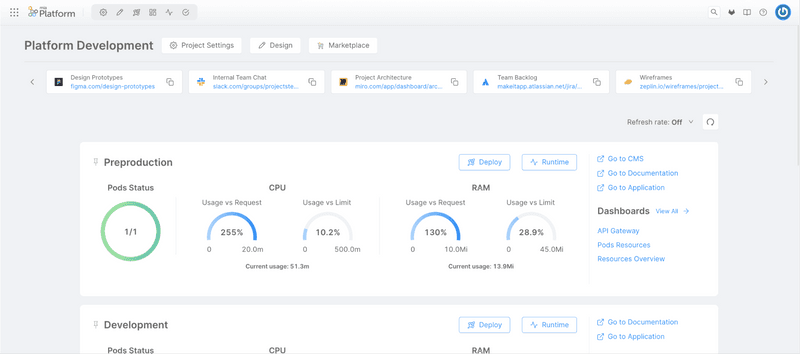 Mia Platform is a cloud-native application development platform with a strong focus on API management and microservices architecture. Their low-code approach, developer portal, and the analytics dashboard helps streamline and speed up application development.#### Key highlights
Mia Platform is a cloud-native application development platform with a strong focus on API management and microservices architecture. Their low-code approach, developer portal, and the analytics dashboard helps streamline and speed up application development.#### Key highlights - In-built CI/CD pipelines: Automate your continuous integration and continuous delivery workflows. Comes preloaded with best practices out-of-the-box.
- Microservices and APIs: Easily build reusable microservices and manage them centrally. API development portal provides full control over your API lifecycle.
- Integrated developer portal: Mia includes a tailored self-service portal with services and solutions pre-packaged for your developers. Lowers friction and boosts productivity.
- Works with your tools: Integrates with all major code repos, container registries, CI/CD, and Kubernetes providers. Fully complementary to your toolchain.
- Enterprise-ready: Role-based access control, secrets management, infrastructure isolation, and other critical enterprise capabilities are offered.#### Benefits
Mia Platform accelerates delivery through developer self-service, reuse of codified patterns, and streamlined CI/CD pipelines. Productivity is enhanced while cloud costs are optimized through visibility and controls.Specifically, it enables 5x faster app development via low code and ready microservices.It streamlines operations through standards and self-service. And it provides granular controls and isolation to enhance security posture while optimizing costs through infrastructure visibility. For lean teams building cloud-native, API-driven applications, Mia is a robust choice.## 6. Qovery
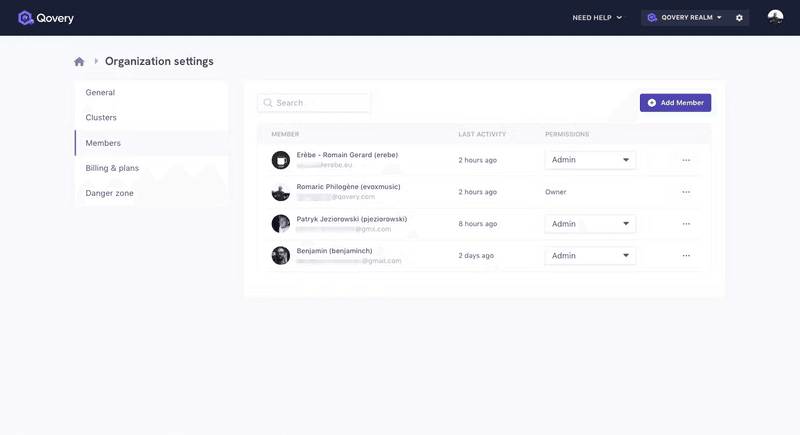 Qovery is a developer-friendly Internal Developer Platform that aims to maximize developer productivity. It simplifies cloud infrastructure management with its easy-to-use interface. It offers CI/CD integration, multi-cloud support, and database management, making it a good choice for Ops teams.#### Key features
Qovery is a developer-friendly Internal Developer Platform that aims to maximize developer productivity. It simplifies cloud infrastructure management with its easy-to-use interface. It offers CI/CD integration, multi-cloud support, and database management, making it a good choice for Ops teams.#### Key features - Provisioning infrastructure: Qovery offers efficient provisioning of cloud infrastructure across public clouds like AWS, GCP and Azure.
- Managing environments: Developers can use Qovery to easily spin up and manage dev, test, and production environments.
- Integrations and self-service: It integrates with popular productivity tools like Slack, Jira etc. Developers get self-service access via CLI and APIs.
- Access controls: Admins can configure fine-grained access controls and enforce custom governance policies.
- Security: Qovery enables security capabilities like 2-factor authentication to enhance your security posture.
- Cost optimization: It helps optimize cloud spends with right-sized infrastructure and Spot instances. Qovery also has partnerships with major cloud providers.#### Key benefits
Qovery enables developers to deliver features 5x faster through accelerated deployments and reduced distractions. It balances rapid shipping of code with governance through robust access controls. With Qovery, you get 50% increased developer velocity, 30% lower overall engineering time spent on infrastructure, and 57% lowered cloud costs through intelligent optimization.#### Customer testimonials
“We’re able to ship our product 5x faster than before while keeping costs under control." - Jean-Baptiste Vieille, Co-Founder, Stupeflix*"Qovery has unlocked productivity between our ops and engineering teams” - Kevin Maschtaler, Platform & Reliability Lead, Tint*With Qovery, engineering teams eliminate infrastructure management overheads and focus on shipping code quickly and efficiently. It brings together developer productivity and cloud optimization in a unified platform.## 7. Appvia
 Appvia specializes in cloud infrastructure management. It focuses on security, cost-effectiveness, and developer enablement. Appvia also offers self-service capabilities and secure isolation features, making it a balanced choice for diverse needs.#### Key capabilities
Appvia specializes in cloud infrastructure management. It focuses on security, cost-effectiveness, and developer enablement. Appvia also offers self-service capabilities and secure isolation features, making it a balanced choice for diverse needs.#### Key capabilities - Self-service infrastructure: Appvia Wayfinder enables developers to self-provision the cloud resources they need through an intuitive web interface.
- Secure isolation: Workloads are isolated through hardened configuration templates baked into Wayfinder. Prevents risks of misconfiguration.
- Temporary credentials: Instead of long-lived credentials, developers get short-lived cloud access only for the duration it's needed. Minimizes credential sprawl.
- Team workspaces: Dedicated cloud environments can be provisioned for teams to manage resources independently without collisions.
- Continuous compliance: Custom policies and constraints can be enforced centrally to ensure configurations remain compliant.
- Integrations: Wayfinder integrates easily with existing CI/CD pipelines and IDEs through self-service API access tokens.#### Key Benefits Appvia boosts productivity by removing roadblocks and delays from infrastructure provisioning while retaining IT oversight. Short-lived credentials and isolated environments prevent sprawl and minimize risks.Specifically, it improves security posture through isolation and ephemeral credentials, optimizes costs by eliminating overprovisioning, and increases developer productivity via frictionless self-service.Centralized control retains oversight while guardrails are provided through automated policy enforcement. The end result is self-service agility with the necessary enterprise guardrails.***Also Read: ***10 Best Cloud Infrastructure Automation Tools****## Conclusion The right Internal Developer Platform tailor-made for your organizational needs and technical environment can tremendously accelerate developer velocity and efficiency. With capabilities ranging from self-service access and standardized configurations to integrated security and cost controls, modern IDPs offer immense value.Facets stands apart with its uniquely open and extensible approach that integrates smoothly across diverse tech stacks. The ability to tailor Facets to your existing workflows and tools provides next-level flexibility. It uniquely integrates across diverse tech stacks to augment your existing toolchain. For engineering teams who want an ever-evolving IDP that adapts to their needs instead of dictating processes, Facets is an outstanding option.Want to test a highly extensible IDP for your business? Book a demo with Facets today and see how we can enhance your workflows!